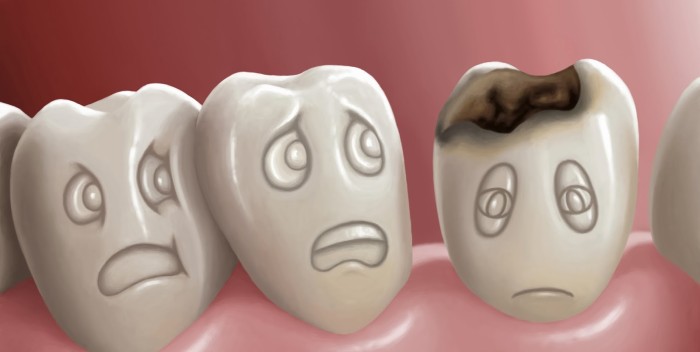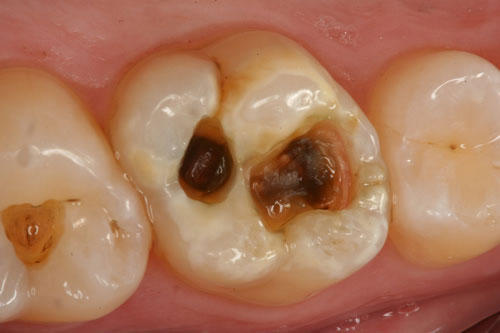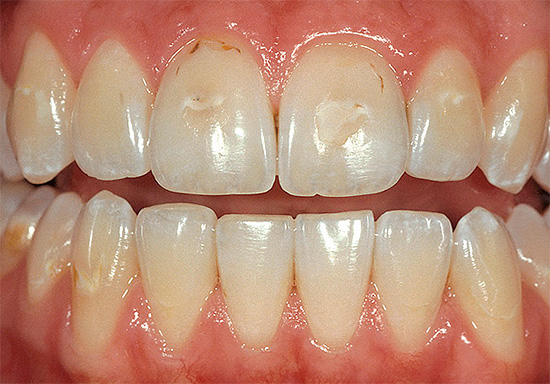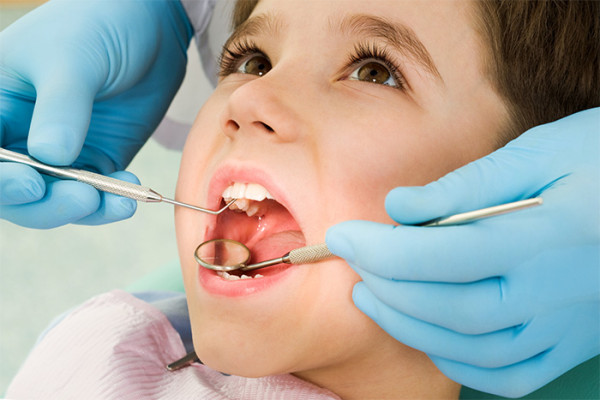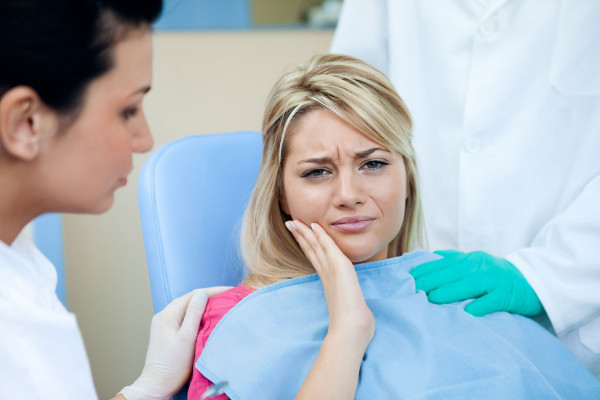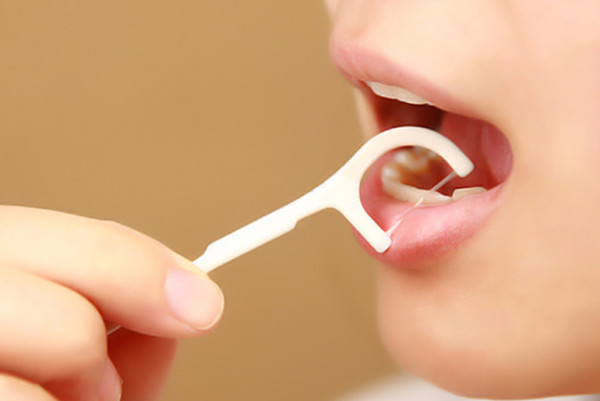Caries: causes, symptoms, treatment, prevention
Improper nutrition, stress, bad habits - all this does not in the best way affect not only overall health, but also dental health. They are the weakest link and are the first to suffer. Tooth decay is the most common problem with teeth, from which, probably, everyone has suffered at least once. Today we will talk about the causes of its occurrence, symptoms and preventive measures that will help prevent it.
Content
Caries: photo
To begin with, a clear example of what the disease looks like in practice.
Causes of caries
It is interesting that over the entire existence of science and caries, more than 400 theories have been proposed as to what is the cause of this disease. We, perhaps, will not go into the details of each of them, but will concentrate all our attention on the one that is recognized by modern medicine.
According to this, the main reason for the formation of caries is the presence of cariogenic microorganisms in the oral cavity, which, with the carbohydrates present in the mouth (very often these are stuck food debris between the teeth), convert them into organic acid. This acid negatively affects first the enamel of the teeth, and then on its insides. It turns out that the main causative agent of caries is poor-quality oral care. Soft plaque, calculus and food debris between teeth are all a joy for bacteria. It is also sad that if the soft plaque is perfectly cleaned off at home, then the tartar is removed only professionally. At the same time, if you do not clean off the soft plaque for several days, it forms tartar and then, microorganisms will begin to multiply around the clock.
Continuing the topic of bacteria, it is worth noting that caries is caused by three types of microorganisms: Streptococcus mutans, Streptococcus sanguis and Actinomycetes. In addition, it has been observed empirically that the influence of their life activity is far from the same for people. In some, they develop actively, while with others they "sleep" more. First of all, this is understandable. by the strength of immunity... The stronger it is, the less chance of getting dental problems and vice versa.
But that's not all. There are other factors that can also provoke the mentioned dental disease, these are:
- Fluency of teeth. It makes oral hygiene problematic, moreover, it is in these cases that food gets stuck between the teeth most often.
- Small amount of saliva and slow secretion. Saliva helps to flush the teeth to some extent. A healthy person produces from one and a half to two liters of saliva per day.
- Insufficient acidity of saliva. In normal condition, saliva has a high alkali content, which negatively affects pathogens. Otherwise, the low alkaline environment is a boon for cariogenic microbes.
- The most common cause of tooth decay is unhealthy diet. A large amount of carbohydrates in the diet, a lot of sugar, especially if this is combined with neglect of oral hygiene - inevitably leads to illness.
Caries symptoms
Obvious signs of caries are sharp pain under the influence of third-party factors, including:
- thermal effect (cold or hot water, or air);
- chemical exposure (sweet, salty or sour foods).
Moreover, if there are no stimuli, then there is no pain. Caries itself does not cause discomfort, it does not have spontaneous pain. One has only to eliminate the factor, as the pain immediately stops. Spontaneous pain is characteristic of Pulpitis when caries has passed into a new stage.
With a deep form of caries, pain can be observed at the time of pressing on the affected tooth. As a rule, this is especially noticeable at the time of eating, chewing or biting. Severe pain occurs at the moment food enters the kyrious cavity, but the removal of food from the diseased area dramatically relieves discomfort.
Difference Between Caries and Pulipitis
- Caries is characterized by pain only with external stimuli, as soon as they are eliminated, the pain also disappears.
- Acute pulpitis is always an acute pain, it is spontaneous and has nothing to do with any irritants.
- But chronic pulpitis still gives pain when exposed to heat. In this case, the difference is that the pain from caries immediately disappears after the removal of the stimulus, and with pulpitis it lasts for 15 minutes.
How to recognize caries on your own
First of all, these are painful sensations, which we talked about earlier. The second symptom is sharp edges and unevenness of the tooth at the site of the lesion, which are easily felt by the tongue. With caries, bad breath is also noted, since food debris that gets stuck in the carious cavity under the action of microbes begins to rot. A simple examination of the tooth in the mirror helps to determine caries well. Darkening of tooth enamel can signal a problem.
Caries stages
There are four types of caries:
- The stage of origin. A dark or light speck can be seen on the tooth. The person does not notice any other changes, pain sensations, there are no enamel defects.
- Superficial stage of caries. At this stage, damage to the enamel becomes noticeable, but the inside of the tooth remains intact.
- The middle stage of caries. The process of destruction proceeds to the upper and middle areas of the dentin, but the deep layers remain intact.
- Launch stage. The process when the destruction of deep layers of dentin occurs.
If the disease has not been treated, then the infection begins to seep into the pulp of the tooth and an inflammatory process called Pulpitis is provoked. If, at this stage, treatment does not come, the infection begins to spread further, spreading to the tissues that surround the roots of the affected tooth. Then a cyst forms at the top of the nerve, a purulent sac, which is called Periodontitis.
Bottle caries
This variety caries characteristic for dairy little teeth, when defeat happens « massively "... As a rule, such a reaction of the body is due to improper or insufficient dental care, as well as improper nutrition.
This is the earliest type of caries, which often occurs in children between the ages of one and three years. The baby's risk of caries depends largely on the duration of breastfeeding and artificial feeding. Before one year old, dental disease is diagnosed in 6% of cases, up to one and a half years - 25%, up to two years - 40%. Bottle caries is a serious matter and should not be started in any case, since in advanced stages it can lead to the death of molars.
Causes of bottle caries
As in adults, the main cause of children's caries is a point accumulation of bacteria that generate organic acids that negatively affect the condition of the teeth, weak immunity, poorly cleaned teeth, etc. The exact cause of the onset of caries can only be determined by a specialist.
Classification of caries
Here, too, the situation looks the same as in ordinary caries, the same 4 stages: inception, initial, middle, neglected.
Bottle caries treatment
Dental treatment for children is not an easy task and not a quick one. First you need to establish contact between the baby and the doctor, choose adequate anesthesia. If the stage is initial, then you can apply a solution with silver ions, which is applied to the surface of the teeth. But this method is good for "freezing" the development of bacteria. In addition, it is this technique that is characterized by persistent staining of the teeth in black. But modern dentistry can offer alternative methods of treatment that will not cause aesthetic discomfort, however, all this should be discussed with the doctor.
In advanced cases, only complete removal of milk teeth is possible.
Bottle caries can lead to problems with permanent teeth and must be treated urgently. Better yet, provide prevention. First of all, it is the observance of the usual rules of hygiene. Limit the number of feedings with formula milk and breast milk at night, switch your baby's nutrition to solid foods in a timely manner and use baby toothpastes. Take your child for preventive examinations to the dentist from the moment the first teeth appear.
Caries - what to do
In the early stages, as a rule, caries proceeds bases of any symptoms, so many do not even suspect about its development, especially since even a regular self-examination can show false results. After all, it is possible that the lesion center will be located out of sight. Therefore, visit your dentist regularly as a preventive measure (at least once a year).
However, if you notice a manifestation of the disease, make an appointment with a specialist in the very near future. Treatment of caries at the initial stage does not provoke any unpleasant sensations and takes very little time. Therefore, it is better not to delay the process and solve everything at once.
Caries treatment
The dentist will first determine the stage of the disease, how much caries is developed, and only after that he will select a treatment method. Moreover, as mentioned above, the earlier the treatment procedure begins, the better.
At the earliest stage, when there is no tooth decay, remineralization with a special solution will be quite sufficient. In the case of superficial and moderate lesions, the treatment of the carious cavity and filling are organized. Deep caries requires serious measures with the use of medicinal pads that contribute to the appearance of a "second" dentin, which will ensure the integrity of the dental nerve.
Caries treatment at home
Home caries treatment is best used as a last resort. If there is an opportunity to seek help from a specialist, do not neglect it. And yet, such treatment shows good results only in the very early stages of the disease, when there is no decay of teeth and enamel.
So, consider the methods of traditional methods of treating caries.
- Sage. Pour a tablespoon of sage with a glass of boiling water, cover and let it brew for about an hour. With this composition, you should rinse the oral cavity and apply a gauze soaked in the solution to the sore tooth for a while. Sage is a natural antiseptic that kills harmful bacteria and tooth decay stops developing.
- Propolis. Roll a small pea out of propolis and attach it to the aching tooth, slightly pressing down. Leave it on for half an hour.
- Laundry soap. Prevention and treatment of dental caries with laundry soap consists in the usual cleaning of teeth with this tool. Prepare a solution by shaking the soap in water, soak a toothbrush in it, and then everything happens in the usual way. The healing property of soap is due to the presence of gamma globulin in it. It is the latter that is responsible for the destruction of the fungus, Trichomonas and bacteria. Once on the tooth, soap destroys microorganisms and caries stops developing.
- Onion husks. A simple mouthwash with a decoction of onion peels will also have a healing effect on the teeth. Cooking is as easy as shelling pears. Pour three large tablespoons of onion husks with one and a half liters of boiling water. Bring the mixture to a boil, remove from the stove and strain through several layers of cheesecloth. The broth should be infused for 8 hours, and after that it will be ready for use. Onion peels will disinfect the oral cavity, relieve pain - just rinse your mouth with broth several times a day.
- Air. Pour 0.5 cups of chopped calamus root with half a glass of vodka. Cover with a tight lid and let it brew for at least a week. With the finished composition, you need to rinse your mouth for about three minutes, after which the tincture is spit out. Do the procedure daily before bed until satisfactory results are obtained. To enhance the effect, at the time of preparation, about 20 g of propolis can be added to the calamus.
- Fir oil. Soak a cotton swab in fir oil and apply it to the affected area for a few minutes. By the way, fir oil remarkably relieves aching toothache.
- Camphor alcohol. Works on the same principle as fir oil. Soak a swab in the composition and apply to the problem area for a few minutes.
- Use garlic to relieve pain. Apply the gruel from it to the sore spot and wait a little, the pain will subside very soon.
Let us remind you once again that all the methods described above are an opportunity to stop the reproduction of bacteria, but caries itself is unlikely to be cured of this. Therefore, to get rid of it, see your dentist.
Prevention of caries
It is always better to fight any disease even before its onset, i.e. routine prophylaxis. It does not take a lot of effort, but it eliminates 99% of the appearance. Preventive measures to prevent tooth decay are very simple.
- Spend more time brushing your teeth and do it well. You can consult with a dentist who will show you how the process should work correctly, or watch the videos, of which there are plenty on the Internet.
- Chew sugar-free gum after meals. According to statistics, in people with this habit, holes in the teeth are observed much less often than in those who ignore this simple rule. This is probably one of the few cases when advertising really speaks the truth.
- Reduce your intake of sweet and sticky foods. By the way, dentists say that the harm of sweets to the teeth directly depends on how long the sweet product is in the mouth. So, for example, eating a slice of chocolate will bring several times less harm than sucking a lollipop.
- Use dental floss. It helps to remove food stuck between your teeth.
- And, of course, the highest quality and most effective caries prevention is a regular visit to the dentist. This will allow caries to be diagnosed at a very early stage and will help to avoid long-term treatment.
